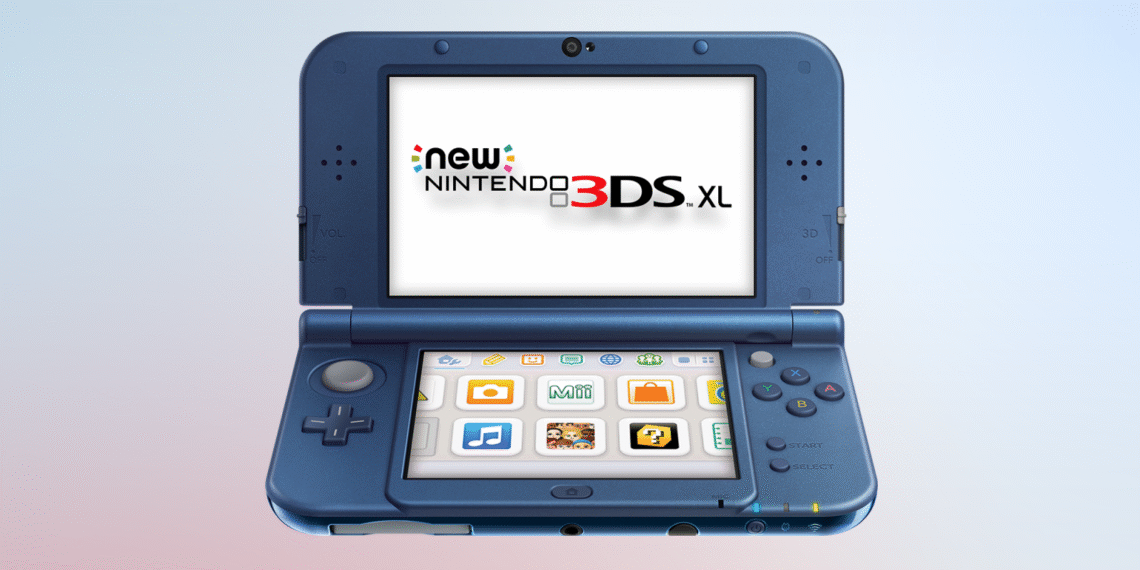The history of handheld consoles is filled with milestones, but few stand out quite like the Nintendo 3DS XL. This device didn’t just make screens bigger — it changed how people experienced portable gaming. With bold innovations, a strong library, and unforgettable social features, the Nintendo 3DS XL left a mark that still resonates today.
The Rise of a Bigger 3DS
By 2012, Nintendo already had a long track record of successful handhelds, from the Game Boy to the Nintendo DS. Yet, fans of the original 3DS often wished for a more immersive display and longer playtime. The solution arrived in the form of the Nintendo 3DS XL.
Released in Japan and Europe in July 2012, and shortly after in North America, the console came with nearly 90% larger screens compared to the standard 3DS. The top display measured 4.88 inches and the bottom 4.18 inches, making games feel richer and easier to enjoy. The XL also offered better battery life, improved ergonomics, and a sturdier design.
At launch, it wasn’t meant to replace the original 3DS but to provide an alternative. Gamers who wanted comfort for long sessions and a more cinematic feel quickly saw the value in upgrading.
Bold Features That Defined the Experience
The Nintendo 3DS XL wasn’t just about size — it was about elevating the handheld experience. Several standout features helped define its success.
Larger Display and Comfort. The bigger screens provided deeper immersion. For players spending hours exploring dungeons in Zelda or catching Pokémon, the XL’s design meant less eye strain and a more enjoyable experience.
Glasses-Free 3D. The most famous feature of the 3DS family was its ability to display stereoscopic 3D without glasses. On the XL’s larger screens, the 3D effect was more striking, though it wasn’t perfect. Some players loved the depth, while others turned it off due to eye fatigue or angle limitations.
Backward Compatibility. One of Nintendo’s smartest moves was ensuring the 3DS XL could play most Nintendo DS titles. This instantly gave the handheld access to a massive library, making it appealing for both newcomers and long-time Nintendo fans.
StreetPass and SpotPass. The console encouraged social interaction in ways no handheld had before. StreetPass allowed players to exchange data just by walking past other users, while SpotPass quietly downloaded updates and special content in the background. These features created a sense of community and surprise in everyday life.

The Software That Defined the System
Hardware innovations mattered, but it was the games that truly brought the Nintendo 3DS XL to life.
First-Party Classics. Nintendo delivered some of its strongest titles for the system. Games like Super Mario 3D Land, The Legend of Zelda: Ocarina of Time 3D, Pokémon X and Y, Animal Crossing: New Leaf, and Fire Emblem Awakening showed just how versatile the handheld could be. Each of these titles helped the XL shine, proving that portable games could be as engaging as console experiences.
Third-Party Success. Beyond Nintendo’s own lineup, third-party developers added variety. Titles like Monster Hunter 4 Ultimate, Bravely Default, and Resident Evil: Revelations provided deep gameplay and attracted fans from different genres.
Indie and eShop Games. The Nintendo eShop gave smaller developers a platform to release innovative titles. Indie games such as Shovel Knight and Mutant Mudds became fan favorites, extending the console’s appeal far beyond major releases.
Cultural and Market Impact
The Nintendo 3DS XL came at a time when handheld gaming faced growing competition from smartphones and tablets. Many doubted whether dedicated consoles could still survive. Yet, the 3DS XL thrived by offering experiences that mobile devices couldn’t match — rich storytelling, iconic franchises, physical buttons, and social interactivity.
Compared to Sony’s PlayStation Vita, the 3DS XL focused less on raw power and more on fun, creativity, and community. This approach resonated with players worldwide. Sales steadily grew, and the XL became the most popular model in the 3DS family, helping the entire line sell over 75 million units during its lifetime.
StreetPass, in particular, became a cultural phenomenon. Gamers carried their systems everywhere, hoping to exchange Mii avatars and unlock surprises. For a time, it transformed everyday spaces like train stations and coffee shops into hubs of unexpected connections.
Challenges and Criticism
As beloved as the Nintendo 3DS XL was, it wasn’t free from criticism.
3D Fatigue. While the glasses-free 3D was groundbreaking, not everyone loved it. Some users experienced headaches or found the effect uncomfortable for long play sessions. Nintendo even added parental controls to limit 3D use for younger players.
Battery Life Concerns. Although the XL improved battery performance compared to the original 3DS, many still found it lacking for long trips. Players often carried chargers or turned off 3D to extend playtime.
Pricing Struggles. At launch, the 3DS family faced slow sales due to its high price point. Nintendo had to cut prices and offer value bundles to keep momentum going. Once the XL launched, however, many saw it as the version worth investing in.
End of Support. In later years, Nintendo began winding down services. The closure of the 3DS eShop in 2023 and the discontinuation of repair services marked the end of an era. This raised concerns about game preservation and the loss of digital titles unique to the system.
The Lasting Legacy of the Nintendo 3DS XL
Even though production has ended, the Nintendo 3DS XL remains deeply cherished by fans and collectors.
Collector’s Editions. Limited edition models, such as those themed around The Legend of Zelda or Pokémon, are highly sought after today. These designs not only captured the spirit of their games but also became cultural symbols of the 3DS era.
Nostalgia Factor. Many players continue to revisit their 3DS XL systems to replay favorites or discover titles they missed. The handheld holds strong emotional value, reminding players of a unique period in gaming history.
Influence on the Nintendo Switch. Lessons learned from the 3DS XL — social play, portability, strong libraries, and innovative design — directly influenced the creation of the Nintendo Switch. The hybrid console can be seen as a natural evolution of ideas first tested on the 3DS family.
Final Thoughts
The Nintendo 3DS XL was more than just a bigger handheld. It was a bold step that redefined portable gaming for millions of players. By combining immersive features, unforgettable games, and social interactivity, it managed to stand tall in an era dominated by mobile phones.
Today, its legacy lives on in the memories of those who carried it everywhere, in the collectors who preserve its special editions, and in the DNA of the Nintendo Switch. Portable gaming may continue to evolve, but the Nintendo 3DS XL will always hold a special place in the story of how we play on the go.
FAQs
What is the difference between the Nintendo 3DS and the Nintendo 3DS XL?
The main difference is screen size and comfort. The Nintendo 3DS XL features screens that are about 90% larger than the original 3DS, along with better ergonomics and improved battery life. Both systems play the same games, but the XL provides a more immersive experience.
Can the Nintendo 3DS XL play Nintendo DS games?
Yes. One of the key strengths of the Nintendo 3DS XL is its backward compatibility. Most Nintendo DS and DSi games can be played directly on the 3DS XL, making it a great option for players who want access to both 3DS and DS libraries.
Does the Nintendo 3DS XL still have online support?
Nintendo has officially closed the 3DS eShop, meaning new digital purchases are no longer available. However, online multiplayer features still work for some titles, and physical cartridges continue to function normally.
Is the Nintendo 3DS XL worth buying today?
Absolutely, especially for collectors and fans of Nintendo’s classic franchises. While it is no longer produced, the 3DS XL remains a beloved console with a vast library of iconic games, including Mario, Zelda, Pokémon, and many more.
What made the Nintendo 3DS XL special in gaming history?
The Nintendo 3DS XL stood out for its glasses-free 3D visuals, innovative StreetPass and SpotPass features, and a strong lineup of first-party and third-party titles. It proved that handheld gaming could still thrive in the smartphone era and left a lasting influence on the design of future consoles like the Nintendo Switch.
Also read :A Complete Guide to Valorant Ranks and How They Work















